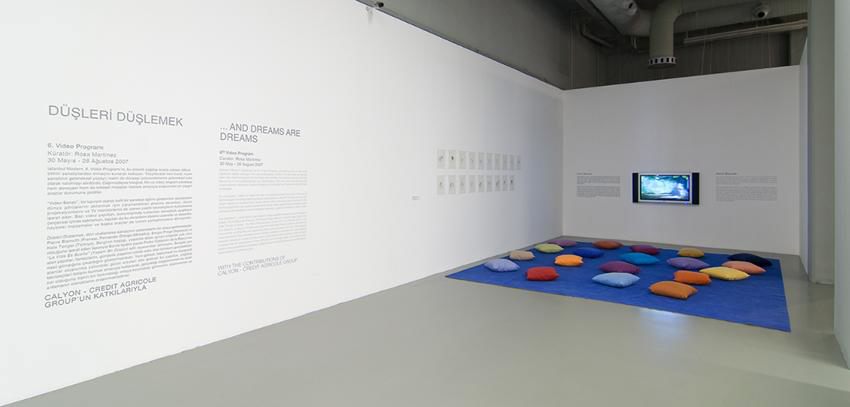- Open Today: 10.00–20.00
- Ticket
- Shop
- Membership
- TR EN
...and Dreams are Dreams
For centuries, canvas has been the classical support for painting, and painting, the classical means of framing the world. In the contemporary era, photography, film and video have become the most common devices to capture images and to project both experimental and mass messages.
As a concept, "video art" does not refer to a specific artistic trend, but to the use of technologies including plasma screens, wall projections and TV monitors as tools with which artists can transmit their visions.Istanbul Modern’s 6th Video Program "…And Dreams are Dreams" brought together the work of four international artists: Pierre Bismuth (France), Fernando Ortega (Mexico), Sergio Prego (Spain) and Hale Tenger (Turkey). The title of the program came from "La Vida es Sueño" (Life is a Dream), a play by the Baroque Spanish dramatist Pedro Calderón de la Barca, who pointed out that the line separating these two spheres is very thin. The selected artworks showed how fantasies reveal hidden realities in everyday life. They expressed beautiful desires to construct new visual, social and emotional realms, which can also translate into an awareness of how difficult it is to change reality. All of these works explored the possibilities of seeing, imagining and understanding using contemporary technologies to communicate.
PIERRE BISMUTH
The work of Pierre Bismuth (Paris, France, 1963) ironically questions established codes of perception. He uses cultural products such as magazines, newspapers and feature films and goes beyond their constructed meaning to alter the perceptions of viewers. Bismuth believes that viewers become wiser by experiencing unexpected perceptual shifts in seemingly usual situations.
The Jungle Book Project (2002) is an installation consisting of a series of drawings, a blue carpet where the spectators can sit, and a plasma screen showing the famous Walt Disney film in the title of the work. Each of the main protagonists speaks a different language: Mowgli speaks Spanish, the panther Bagheera speaks Arabic, the terrible snake speaks Italian, and so on. In total, 19 different languages are used. The amazing thing is that all the characters understand each other perfectly. The dream of a contemporary Babel where language is not a barrier and where everyone can keep their differences becomes a funny and sweet manifesto about the possibilities and difficulties of living together.
FERNANDO ORTEGA
Fernando Ortega (Mexico City, Mexico, 1971) works in a wide range of media: video, photography, installation and sound interventions. His work plays with the gap between perception and unawareness. It seeks to redefine what is taken for granted. Ortega believes that an individual is someone who gives meaning and direction to knowledge. As an artist, he chooses everyday situations in order to reveal the unexpected within them. In this way, he discovers poetic, humorous and sometimes melancholic aspects of reality and invites the spectator to share the pleasure of discovering his visions.
Salto de Eyipantla (Fall of Eyipantla), 2001, is a video where a young boy who works as a tourist guide stands in front of an impressive waterfall. The boy faces the camera while talking about the beauty and power of the location. Slowly water covers the lens of the camera and makes him disappear under its drops. The figurative narration becomes an abstract composition as the subject disappears into his environment, creating fascinating reflections on how nature and culture interact.
SERGIO PREGO
Sergio Prego (San Sebastian, Spain, 1969) works in many different media including video, photography, performance art, installation and sound, but he considers himself above all a sculptor. He uses contemporary technology to distort and reinvent the relationship between the human body and the interior/exterior spaces we inhabit. Prego works with liquids, dust, explosions, and smoke, conceiving of each as sculptural materials. He examines the notions of speed, time and gravity to create disturbing situations. Simulation becomes a tool to produce fictions in which the human body discovers new possibilities of interacting with reality.
Home (2001) is a video that connects the beautiful and the monstrous. Inspired by the cosmetic drops used in make-up advertising, a fluid skin-colored shape moves around the head of the artist, splashes against his face and becomes a continuous interacting element. The notion of the skin as a smooth and perfect surface directly opposes the common image of the inner body: a mess of flesh and bloody organs. The artist transforms a figurative and disturbing extension of the body through the changing, multiform and intriguing volumes of the skin-colored drop.
HALE TENGER
Hale Tenger (İzmir, Turkey, 1960) is known for creating powerful sculptures and installations that analyze her position as a woman, as a Turkish citizen, and as a complex and contradictory contemporary subject. In her installations and video productions, she uses sound and the human voice as an essential element to construct her political narratives. The human voice often has a spectral or ghostly resonance that shows the complexities of individual and social life.
Dream H(a)unter, 2002 presents a fixed image of a café in Nişantası. This mundane place contrasts with a strange narration by a female voice describing her work of haunting dreams as ‘official secrets’. The work makes reference to the regime of martial law of the early 1980s and the subsequent State of Emergency which lasted twenty-two years in some cities in Eastern Turkey, and which was still in effect at the time this work was made. This political context gives a special meaning to the frozen image where yellow birds fly past everyday scene. As the artist explains, these birds refer to a saying in Turkish: "let a bird land on it" meaning that whatever you do, the situation might appear to change but is unlikely to improve.
Curator: Rosa Martínez
